Ideally, you should wait up to 4 weeks for plaster to fully dry before painting.
But in reality most homeowners don’t wait that long.
If you’ve had your walls or room freshly plastered you may be keen to see your chosen colour up on the walls and get your project finished, but painting before the plaster has dried can cause problems for your finished walls further down the line.
So how long should you wait before painting new plaster?
As a general rule of thumb, a newly plastered wall should be left for 28 days before any painting should begin.
Walls should be fully dry both visibly and to the touch. Painting walls before they are ready will cause adhesion problems, and result in cracking and peeling of paint and uneven colour.
How long does it take skim plaster to dry before painting?
A skim coat on plasterboard will need less time to dry, and you may be able to paint around the 14 day mark.
Skimming plaster is the process of applying one thin plaster coat over a surface to prepare it for decorating. It is used to cover any minor imperfections on the existing plastered wall, or to provide a smooth base for paint or wallpaper to a plasterboard.
A skim plaster coat alone will be thinner and therefore will require less drying time.
If you have had your walls fully replastered with several layers, your walls will understandably take longer to dry and you can expect to wait up to 6 weeks before your painting can begin.

How will I know that my plaster is dry?
Your plasterer or decorator will be able to advise you on how long to leave your plaster before painting, but there are some signs you can look out for to help you decide when your plaster is dry enough to paint.
When wet and freshly applied it will appear brown, this changes to a more pink hue as it dries. Once it’s fully dry, the colour will be consistent across the whole wall, lighter and darker patches suggest the wall is not consistently dry enough yet.
You should also ensure that there is no plaster dust remaining before your painting job begins.
You can speed up the drying process by maintaining an ambient temperature.
Increase the airflow by cracking open a window or two, and ensure humidity is kept to a minimum by considering using a dehumidifier in the room. Be careful about using too much heat. It may be tempting to crank up the temperature and turn up your radiators, but plaster that dries too fast will be at risk of large cracks which will show or appear under your paintwork.
Be sure to factor in drying time when planning your next renovation project.
If you’re thinking of hiring a plasterer but aren’t sure of the costs involved, read our guide about the costs involved with plastering.
If you’d like to understand more about the costs involved with the steps that may take place after plastering, read our guide about the costs to paint and decorate a room or tiling costs.
Get your free plastering and decorating quotes today.